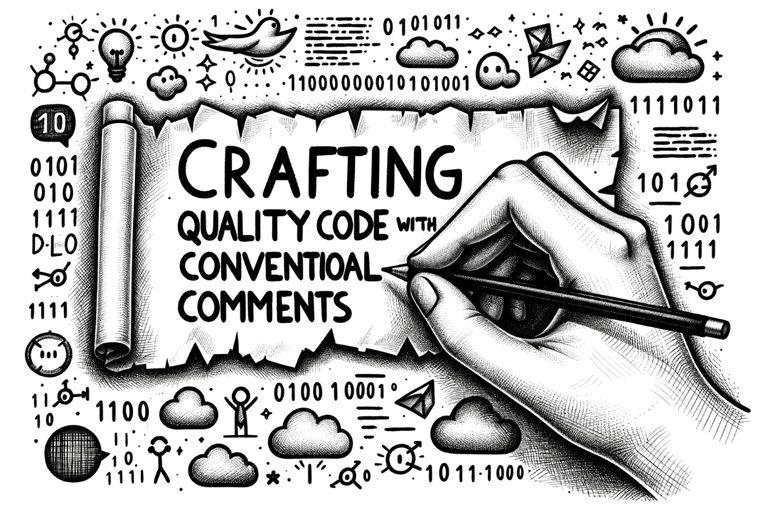
Crafting Quality Code with Conventional Comments
As a software engineer that’s been around for some time, I’ve come to appreciate the transformative power of well-structured code reviews. It’s not just about catching bugs or ensuring adherence to coding standards; it’s about cultivating a culture of collaboration, continuous improvement, and crafting code that stands the test of time. One methodology that has significantly elevated the effectiveness of code reviews in my experience is the use of “Conventional Comments”.
Conventional Comments 🔗 is a pragmatic approach to systematizing the code review process. It’s like having a well-organized toolbox, where each tool has a specific purpose and its designated place. By adopting this methodology, code reviews become more focused, efficient, and impactful.
Let me share some key aspects of how Conventional Comments have revolutionized the code review process in my team:
1. Categorizing Feedback for Clarity:
One of the core principles of Conventional Comments is categorizing feedback into predefined buckets such as suggestion, issue, thought, question, and nitpick. This categorization encourages reviewers to be intentional and explicit about the nature of their feedback. Instead of vague or ambiguous comments, reviewers provide clear and actionable insights.
For example, when suggesting an improvement, a reviewer might comment:
- suggestion: Consider extracting this reusable logic into a separate utility function to enhance code modularity and maintainability.
By prefixing the comment with suggestion, the reviewer conveys that this is a recommendation rather than a mandatory change. It sparks a conversation about the potential benefits and trade-offs of the proposed modification.
2. Enhancing Communication Efficiency:
Conventional Comments introduce a standardized set of prefixes that enable reviewers to express their intentions concisely. This not only saves time but also facilitates quicker comprehension of the feedback. When reviewers use consistent prefixes, it becomes easier for the code author to grasp the context and significance of each comment.
For instance, when pointing out a potential issue, a reviewer might write:
- issue: The current implementation has a risk of introducing race conditions. Let’s explore using a mutex or a synchronization mechanism to ensure thread safety.
The issue prefix immediately draws attention to a problem that needs to be addressed. It prompts the code author to investigate the concern and collaborate with the reviewer to find an appropriate solution.
3. Fostering Constructive Conversations:
Conventional Comments create an environment where feedback is delivered constructively and respectfully. By providing a structured framework for commenting, it encourages reviewers to focus on the code itself rather than personal preferences or subjective opinions. The emphasis is on nurturing a dialogue that leads to collective growth and improvement.
For example, when seeking clarification, a reviewer might ask:
- question: How does this function handle edge cases such as empty input or invalid data? Can we add appropriate error handling and documentation to cover these scenarios?
By framing the comment as a question, the reviewer opens the door for a productive discussion. It encourages the code author to think critically about the robustness and resilience of their implementation.
4. Continuous Learning and Knowledge Sharing:
Conventional Comments transform code reviews into opportunities for continuous learning and knowledge sharing. Each comment becomes a nugget of wisdom that contributes to the collective knowledge base of the team. By adopting a structured approach, developers can easily refer back to previous reviews and leverage the insights gained to make informed decisions in future development tasks.
For instance, when sharing a best practice, a reviewer might suggest:
- thought: In this scenario, we can apply the Singleton pattern to ensure a single instance of the configuration object throughout the application lifecycle. This will improve resource utilization and maintain consistency.
Such comments not only address the immediate concern but also impart valuable design patterns and architectural principles that can be applied in similar contexts.
Practical Tips for Adopting Conventional Comments:
-
Start Small: Begin by introducing Conventional Comments in a pilot project or a specific module of your codebase. This allows your team to familiarize themselves with the methodology and gradually scale it across the entire project.
-
Establish Guidelines: Collaborate with your team to establish clear guidelines on how to use Conventional Comments effectively. Define the specific prefixes and their meanings, and provide examples of well-structured comments. Consistency is key to reaping the benefits of this approach.
-
Integrate with Tools: Leverage code review tools that support Conventional Comments natively or through extensions. This streamlines the commenting process and ensures that the prefixes are prominently visible and easily searchable.
-
Encourage Participation: Foster a culture where everyone in the team actively participates in code reviews using Conventional Comments. Lead by example and provide constructive feedback to encourage others to adopt this methodology.
-
Continuously Refine: As your team gains experience with Conventional Comments, gather feedback and iterate on the process. Identify areas for improvement and adapt the methodology to suit your team’s specific needs and workflow.
Embracing Conventional Comments is not about overhauling your existing code review process; it’s about enhancing it with a structured and purposeful approach. It’s like adopting a proven recipe that elevates the flavor and quality of your dish. By infusing clarity, efficiency, and constructive feedback into your code reviews, you’ll witness a significant improvement in code quality and team collaboration.
As a software engineer who has experienced the transformative power of Conventional Comments firsthand, I wholeheartedly recommend giving it a try. Embark on this journey and observe how it nurtures a culture of continuous improvement, knowledge sharing, and collaborative growth within your development team.
Remember, every comment is an opportunity to learn, refine, and elevate the quality of your codebase. Embrace Conventional Comments and unlock the true potential of your code reviews.
Happy coding and reviewing!
Stay in touch
Don't miss out on new posts or project updates. Hit me up on X (Twitter) for updates, queries, or some good ol' tech talk.
Follow @zkMake Written by Zubin Khavarian
Written by Zubin Khavarian